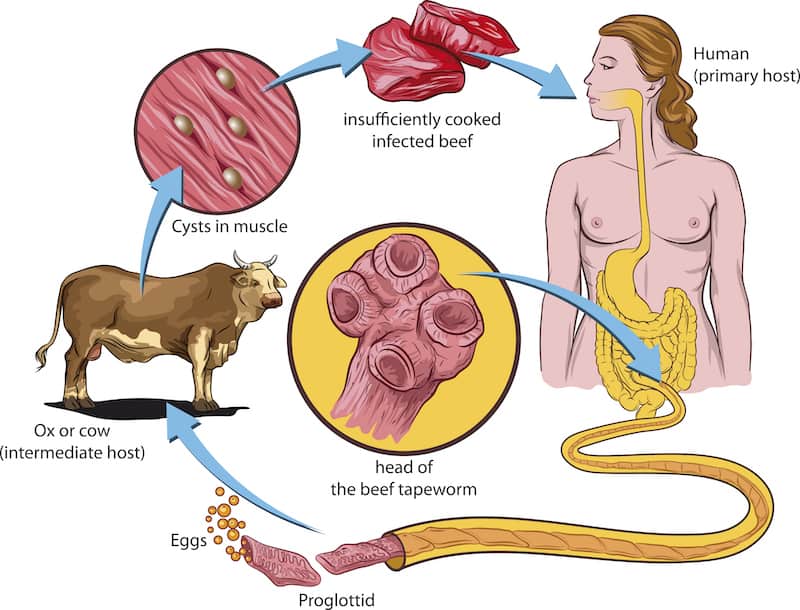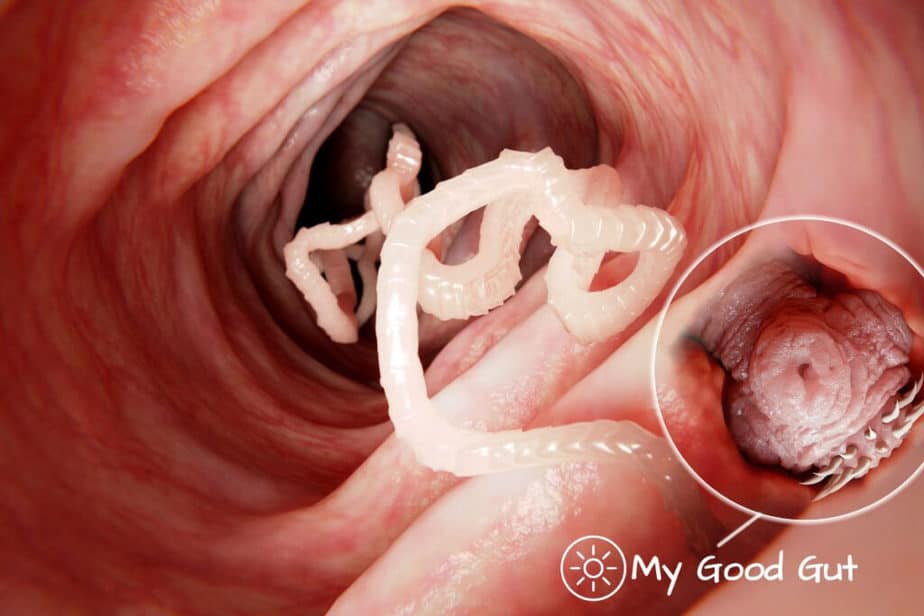Tapeworms are among the oldest known parasites. These pesky parasites can wreak havoc on your digestive system if left untreated, so it’s important that you educate yourself on their symptoms, treatments, and prevention.
Tapeworms are flatworm parasites that live in the intestines of animals and humans alike. While not always harmful, they can cause serious health problems if left unchecked.
Symptoms can include abdominal pain, diarrhea, weight loss, and even nervous system damage in severe cases. But fear not – there are effective treatments available for those who find themselves infected with this unwelcome guest.
Understanding The Basics Of Tapeworms
Tapeworms are described as flat and ribbon-shaped. Tapeworms vary in size from 6 inches to 26 ft long depending on the type of tapeworm. They have three parts to their body: head, neck, and body segments called proglottids.
These parasites are not uncommon and can infect humans through various transmission methods. Prevalence rates vary depending on geographic region and certain risk factors.
Tapeworm infections occur when individuals ingest either contaminated food or water that contains the larvae of the tapeworm. Additionally, contact with infected animals such as dogs or cats can also lead to infection.
It is important to note that not all species of tapeworm affect humans, but those that do can cause significant health issues if left untreated.
Tapeworms come in more than 1,500 different species. Infections in the United States are mainly caused by three species: the beef tapeworm, the fish tapeworm, and the dwarf tapeworm (the smallest species that will infect humans).
The head has hooks for attaching itself to the intestinal wall. If the head stays attached to the intestinal wall, it can survive and grow into a new tapeworm. The proglottid contains eggs that can break off into the bloodstream and travel throughout the body, causing symptoms.
Tapeworms don’t have intestines; they absorb partially digested materials from their hosts through their skin. Adult tapeworms can live and thrive in the digestive tracts of a variety of hosts, such as humans, dogs, cats, cows, pigs, and fish.
Most tapeworm species have both male and female sexual organs, and reproduce and produce their own offspring.

Learn more about a parasite infection in this article.
Symptoms of Tapeworm Infection
Tapeworms can be contracted through various means such as consumption of undercooked meat or contact with contaminated fecal matter.
Here are common signs and symptoms of a tapeworm infection:
- Abdominal Discomfort
- Diarrhea
- Malnutrition
- Muscle Weakness
- Neurological Damage
- Weight loss
Common Tapeworms
These are the common types of tapeworms.
- Beef tapeworms usually range between 10 and 15 feet, but can even grow up to 65 feet long. Cows and humans are the most common hosts for the parasite, but they can only reproduce asexually in humans.
- Dwarf tapeworms are the smallest kind of tapeworm that affects humans. They are only a few tenths of an inch long. They live in the intestines of humans and rats.
- Pork tapeworms will usually grow between 1/4 and 1/2 inch long, and live in humans and pigs.
- Fish tapeworms are the longest tapeworm species, averaging about 30 feet long, but can grow up to 100 feet. They can infect humans, dogs, cats, bears, seals, and weasels.
In North America, the beef tapeworm (taenia saginata) is the most common, but it’s relatively controlled, so it’s doesn’t invade easily. In Latin America, the pork tapeworm (taenia solium) infects millions. The fish tapeworm (diphyllobothrium latum) and pork tapeworm are most common in Asia.
Tapeworms are born from eggs which then develop into adventurous embryos. They leave the host’s digestive system through their bowels and then find the nearest source of water. Baby tapeworms are ingested by both animals and humans regularly.
Tapeworm embryos are ingested by drinking contaminated water or by direct contact with feces. That’s another good reason to always wash your hands after using the toilet.

The Life Cycle Of Tapeworms
It is crucial to understand the life cycle of these parasites as well as their transmission routes in order to prevent and treat them effectively. Tapeworms undergo several life stages starting from an egg to larvae, which then develop into adult worms.
The eggs are usually ingested by animals such as pigs or cows, where they hatch and migrate through the animal’s body before becoming adults.
When humans consume undercooked meat infected with tapeworms, they can become hosts for these parasites too.
Apart from consuming contaminated meat, other transmission routes include poor hygiene practices like unclean hands or exposure to fecal matter containing tapeworm eggs. This highlights the importance of practicing good hand hygiene and sanitation habits at all times.
Understanding the different stages of a tapeworm’s life cycle and its various transmission routes is essential in preventing infection.
Tapeworm Assumptions
It’s a common assumption that embryos grow into full-grown tapeworms, but they usually don’t. The undeveloped tapeworms burrow through their host’ s abdominal lining and enter the bloodstream.
Veins and arteries transport the tapeworms from one organ to another.
Once the embryo finds a place where it can develop, it forms a fluid sac (a cyst) around itself. The embryo doesn’t leave the sac until the host’s flesh has been eaten by another animal. Tapeworms usually get into your body through food.
Tapeworm Prevention
One important factor to consider when dealing with tapeworms is the diet that you follow. Certain foods can promote the growth and spread of these parasites within your body.
There are a number of prevention steps you can take to avoid a tapeworm infection:
- Avoid undercooked meat and fish
- Cook meat at temperatures of at least 150 degrees Fahrenheit
- Freeze fish for 24 hours before cooking
- Freeze meat for 12 hours before cooking
- Promptly treat tapeworm in pets or livestock
- Wash hands before and after handling meat or seafood
- Wash hands before eating
- Wash hands after using the toilet
Follow these simple rules and you won’t be one of the millions who deal with intestinal parasites and their unpleasant side effects.
For instance, if your daily meals consist mostly of raw or undercooked meats, it increases your chances of contracting this infection. Therefore, being mindful about what you eat can go a long way in preventing tapeworm infestations.
Another crucial aspect to note is how easily these worms can be transmitted from one person to another. It’s not just limited to ingestion but also through physical contact with an infected individual who may carry the eggs on their skin or clothing.
Hence it becomes imperative that we maintain good hygiene practices like washing hands frequently and avoiding close proximity with those diagnosed with tapeworm infections.
With all the possible ways for transmission and the variety of symptoms caused by tapeworm infections, it’s essential to seek medical assistance at the earliest sign of discomfort. In our next section, let us explore more about diagnosis and testing for tapeworms so that we can take better control over our health outcomes.
Tapeworm Diagnosis and Treatments
To diagnose a tapeworm infection, your doctor will likely begin by asking about any symptoms you’re experiencing and your medical history. They may also conduct a physical exam to check for signs of the parasite in your abdomen or other areas of your body.
One common diagnostic tool is stool analysis. This involves collecting a small sample of your feces and examining it under a microscope for evidence of tapeworm eggs or segments. If no parasites are found on the first sample, additional samples may be needed to confirm or rule out an infection.
In some cases, antibody testing may also be used to detect tapeworm infections. This involves drawing blood and analyzing it for specific antibodies that indicate exposure to the parasite. However, this method isn’t always reliable and may produce false negatives if the infection is still in its early stages.
When it comes to treatment options for this parasitic infection, medications are the most common choice.
Albendazole is commonly used for tapeworms, as well as hookworms, pinworms and roundworms. Sometimes, praziquantel (Biltricide) is also used for the treatment of tapeworms.
It is important to note that while these medications may be effective in treating an active tapeworm infection, they do not provide immunity against future reinfection.
Therefore, managing tapeworm reinfection should also be a priority when undergoing treatment. With proper management and treatment, however, individuals can overcome their tapeworm infection and live a healthy life free from further complications.
If you think you may have a tapeworm, it’s best to see your doctor for diagnosis and treatment options.
Natural And Alternative Remedies For Tapeworms
While medications can provide quick relief from the symptoms of tapeworm infections, natural and alternative remedies are also worth considering for long-term management.
Herbal remedies have been used for centuries to treat various ailments, including parasitic infections. Some herbs that may help fight tapeworms include garlic, pumpkin seeds, wormwood, and clove.
These herbs have anti-parasitic properties that make them effective in eliminating or reducing the number of parasites present in the body. However, it is important to note that not all herbal remedies are safe or effective in treating tapeworm infections.
Dietary changes can also aid in managing tapeworm infections naturally. A well-balanced diet rich in fiber and nutrients helps maintain a healthy gut environment while boosting immunity. Consuming probiotics through fermented foods or supplements can also improve gut health by replenishing beneficial bacteria destroyed by medication use.
By incorporating herbal remedies and dietary changes into your routine, you can build a robust defense system against potential threats such as tapeworm infections.
Natural and alternative remedies should be considered alongside traditional treatments after consulting with your healthcare provider.
Preventing Tapeworm Infections in Pets
Pets are susceptible to tapeworms just like any other animal. However, pet owners can take certain steps to minimize the risk of infection.
Firstly, maintaining pet hygiene is crucial for preventing tapeworm infections. This includes regular grooming, cleaning their living spaces, and disposing of feces promptly. Pet owners should also wash their hands after handling pets or anything related to them. Additionally, it’s important to avoid allowing pets near areas where they may come into contact with infected animals.
Secondly, veterinary care plays a significant role in preventing tapeworm infections in pets. Regular check-ups allow veterinarians to spot potential issues early on and administer preventative measures such as deworming medication. It’s highly recommended that pet owners follow their veterinarian’s advice regarding vaccinations and parasite control treatments.
Lastly, being aware of the signs and symptoms of a tapeworm infection is crucial for prompt treatment. These include vomiting, diarrhea, weight loss, scooting on the ground (due to anal itching), and visible segments of worms in fecal matter or around the anus. If you suspect your pet has a tapeworm infection, seek veterinary care immediately.
By taking these simple yet effective precautions, pet owners can reduce the risk of tapeworm infections in their beloved companions while keeping themselves safe from transmission as well.
Final Thoughts on Tapeworms
Tapeworms are not to be taken lightly. These pesky parasites can cause a wide range of symptoms, from mild abdominal pain and nausea to severe diarrhea and weight loss. And if left untreated, they can even lead to long-term damage to your body.
But don’t worry – there are plenty of treatments available for tapeworm infections. From oral medications to surgical removal in extreme cases, there are a number of tools to help you get rid of these unwelcome guests.
And prevention is key as well – make sure to cook all meat thoroughly and wash your hands frequently, especially before eating or handling food.
So if you’re experiencing any symptoms that may indicate a tapeworm infection, don’t hesitate to seek medical attention. With proper treatment and prevention measures in place, you can keep these parasites at bay and live a healthy life free from their unwanted presence.
Tapeworms FAQs
Can Tapeworms Be Transmitted Through Sexual Contact?
Yes, tapeworms and intestinal parasites can be transmitted both sexually and non-sexually, and that contact with fecal matter is the primary mode of sexual transmission. In particular, oral contact with the anus can lead to transmission of tapeworms and other intestinal parasites.
To prevent the transmission of tapeworms and other intestinal parasites during sexual activity, it is important to practice safe sex. This includes using dental dams or latex gloves during contact with the anus, cleaning the anus before engaging in rimming, using condoms or dental dams during oral sex, and cleaning or using condoms on shared sex toys.
How Long Does It Take For Tapeworms To Mature And Start Causing Symptoms?
Tapeworms can take anywhere from a few weeks to two months to mature inside the body before causing any noticeable symptoms. Early symptoms may include abdominal discomfort, nausea, and diarrhea.
It’s crucial to seek medical attention if you suspect you have been infected with tapeworms as they can cause serious complications if left untreated.
Are Tapeworm Infections More Common In Certain Parts Of The World?
Prevalence rates of tapeworm infections vary greatly depending on the geographic distribution. Certain parts of the world have higher cases of infections due to poor sanitation and hygiene practices.
For example, in developing countries where access to clean water is limited, tapeworms are more common.
However, it’s important to note that even developed countries can still see cases of tapeworm infections through contaminated food or contact with infected animals.
Understanding the prevalence rates and potential sources of infection can help individuals take control over their health by taking preventative measures such as practicing good hygiene and avoiding high-risk foods.
Can Tapeworms Cause Long-Term Damage To The Body If Left Untreated?
While it’s true that some species can lead to complications such as anemia, timely treatment can usually prevent any serious harm from occurring.
That being said, it’s important to seek medical attention promptly if you suspect you may have tapeworms – delaying treatment out of fear or misinformation could ultimately put your health at risk.
So ask yourself: do you want to take control of your health by seeking information and treatment, or let misconceptions and myths hold you back?
Sources:
- National Library of Medicine: https://www.ncbi.nlm.nih.gov/books/NBK537154
- Science: https://www.science.org/content/article/tapeworms-may-be-good-your-brain
- Michigan State University: https://www.canr.msu.edu/news/tips_to_help_you_avoid_tapeworms
- Center for Disease Control: https://www.cdc.gov/parasites/taeniasis/index.html

